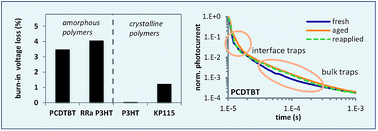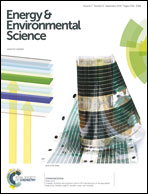Reducing burn-in voltage loss in polymer solar cells by increasing the polymer crystallinity†
Abstract
In order to commercialize polymer solar cells, the fast initial performance losses present in many high efficiency materials will have to be managed. This burn-in degradation is caused by light-induced traps and its characteristics depend on which polymer is used. We show that the light-induced traps are in the bulk of the active layer and we find a direct correlation between their presence and the open-circuit voltage loss in devices made with amorphous polymers. Solar cells made with crystalline polymers do not show characteristic open circuit voltage losses, even though light-induced traps are also present in these devices. This indicates that crystalline materials are more resistant against the influence of traps on device performance. Recent work on crystalline materials has shown there is an energetic driving force for charge carriers to leave amorphous, mixed regions of bulk heterojunctions, and charges are dominantly transported in pure, ordered phases. This energetic landscape allows efficient charge generation as well as extraction and also may benefit the stability against light-induced traps.


 Please wait while we load your content...
Please wait while we load your content...